“Global Vision Sensor Market to reach a market value of USD 8.2 Billion by 2030 growing at a CAGR of 11.3%”
The Global Vision Sensor Market size is expected to reach $8.2 billion by 2030, rising at a market growth of 11.3% CAGR during the forecast period.
Asia Pacific is a major player in the electronics and semiconductor industry, and vision sensors play a critical role in producing semiconductors, PCBs, and electronic components. Consequently, the Asia Pacific segment captured $1,310.5 million revenue in the market in 2022. These sensors contribute to quality assurance, inspection, and precision measurement, aligning with the high-tech manufacturing requirements of the region. The Asia Pacific region has seen rapid growth in robotics and automation, and vision sensors are integral components in robotic systems.
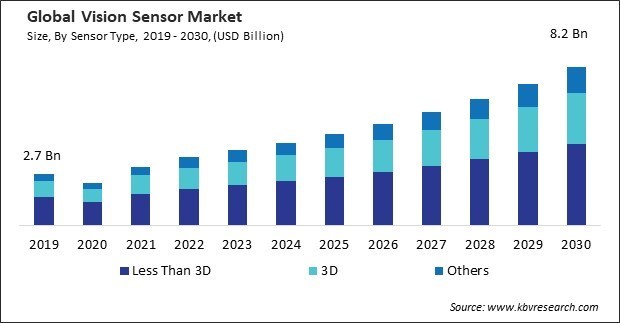
The major strategies followed by the market participants are Product Launches as the key developmental strategy to keep pace with the changing demands of end users. For instance, For Instance, In November, 2023, Teledyne e2v unveiled the Emerald Gen 2 CMOS image sensor line. The sensors come in 21 x 20 mm Ceramic Land Grid Array packages, and they are offered in either 8.9 MPixel or 12 MPixel resolution, available in monochrome or color, and in standard or high-speed grades. Additionally, in September, 2023, Cognex Corporation unveiled the In-Sight SnAPP sensor. The In-Sight SnAPP is crafted for simplicity and easy deployment, offering customers a straightforward entry point into machine vision technology.
Based on the Analysis presented in the KBV Cardinal matrix; Keyence Corporation is the forerunners in the Market. Companies such as Teledyne Technologies, Inc., Omron Corporation and Cognex Corporation are some of the key innovators in the Market. For Instance, In May, 2023, Cognex Corporation launched the Advantage 182 vision system, an industrial machine vision system. Through this product, the company seeks to automate intricate location, classification, and inspection tasks. The Advantage 182 vision system incorporates advanced machine vision, barcode reading, and edge learning technology to automate a wide range of tasks, spanning from basic presence/absence detection and track-and-trace applications to precise alignment and sophisticated color inspections.
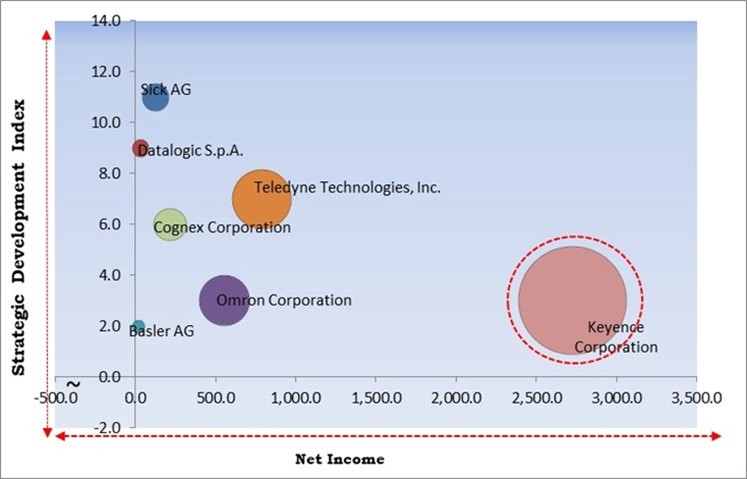
Industry 4.0 emphasizes implementing automated inspection and quality control processes to ensure high product quality and consistency. These sensors are deployed in manufacturing lines to perform real-time inspections, identify defects, and verify product specifications. These sensors play a vital role in tracking products throughout production, verifying serial numbers, and ensuring adherence to regulatory standards. Therefore, the market is expanding significantly due to the rising adoption of industry 4.0 and smart manufacturing.
Additionally, E-commerce fulfillment centers and logistics hubs deploy vision sensors for the automated sorting of packages. As per the International Trade Administration, global e-commerce sales for B2B businesses have gradually increased over the last decade, with the global B2B e-commerce industry expected to be worth USD$36 trillion by 2026. Thus, because of the rapid growth in e-commerce and logistics, the market is anticipated to increase significantly.
High initial costs may limit the frequency of system upgrades or expansions. Organizations may exhibit risk aversion when considering high-cost investments, particularly in economically uncertain times. The perceived financial risk associated with implementing sensor systems can result in delayed or deferred investment decisions, impacting the overall market growth.
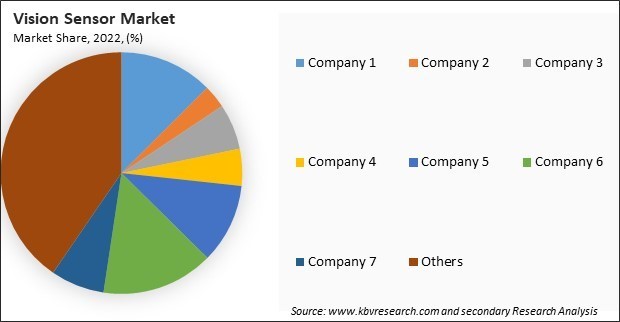
The leading players in the market are competing with diverse innovative offerings to remain competitive in the market. The above illustration shows the percentage of revenue shared by some of the leading companies in the market. The leading players of the market are adopting various strategies in order to cater demand coming from the different industries. The key developmental strategies in the market are Product Launches and Product Expansions.
By sensor type, the market is categorized into less than 3D, 3D, and others. In 2022, the less than 3D segment held the highest revenue share in the market. Less than 3D sensors are employed for printed text and character recognition. Optical character recognition (OCR) technology is used in applications like document processing to extract text from images. These sensors assist in reading and interpreting printed characters on documents, labels, and packaging, enhancing automation in administrative tasks.
On the basis of end user, the market is divided into automotive, electronics & semiconductor, consumer electronics, pharmaceuticals, food & packaging, and others. The electronics & semiconductor segment procured a promising growth rate in the market in 2022. These sensors play a crucial role in wafer inspection during semiconductor manufacturing. They detect defects, contaminants, and irregularities on semiconductor wafers.
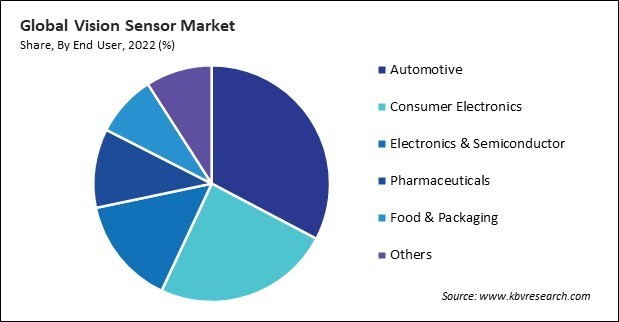
Based on application, the market is classified into inspection, gauging, code reading, and others. In 2022, the inspection segment witnessed the largest revenue share in the market. These sensors are used for surface inspection in material processing industries such as steel, glass, and plastics. They can detect surface defects, irregularities, or contaminants in materials, ensuring the final products meet quality standards. Surface inspection produces high-quality materials for construction, packaging, and other applications.
Free Valuable Insights: Global Vision Sensor Market size to reach USD 8.2 Billion by 2030
Region-wise, the market is analysed across North America, Europe, Asia Pacific, and LAMEA. In 2022, the North America region acquired a significant revenue share in the market. North America, particularly the United States, is home to a robust manufacturing sector that has embraced Industry 4.0 principles. The automotive industry in North America has extensively integrated vision sensors for applications such as advanced driver-assistance Systems (ADAS), autonomous vehicles, and manufacturing quality control.
| Report Attribute | Details |
|---|---|
| Market size value in 2022 | USD 3.5 Billion |
| Market size forecast in 2030 | USD 8.2 Billion |
| Base Year | 2022 |
| Historical Period | 2019 to 2021 |
| Forecast Period | 2023 to 2030 |
| Revenue Growth Rate | CAGR of 11.3% from 2023 to 2030 |
| Number of Pages | 253 |
| Number of Tables | 393 |
| Report coverage | Market Trends, Revenue Estimation and Forecast, Segmentation Analysis, Regional and Country Breakdown, Competitive Landscape, Market Share Analysis, Porter’s 5 Forces Analysis, Company Profiling, Companies Strategic Developments, SWOT Analysis, Winning Imperatives |
| Segments covered | Sensor Type, Application, End User, Region |
| Country scope |
|
| Companies Included | Omron Corporation, Basler AG, Sick AG, Datalogic S.p.A. (Hydra S.p.A.), Balluff GmbH, Teledyne Technologies, Inc. (Teledyne DALSA), IFM Electronics GmbH, Keyence Corporation, Baumer Holding AG, Cognex Corporation |
By Sensor Type
By End User
By Application
By Geography
This Market size is expected to reach $8.2 billion by 2030.
Rising adoption of industry 4.0 and smart manufacturing are driving the Market in coming years, however, High initial costs of vision sensor restraints the growth of the Market.
Omron Corporation, Basler AG, Sick AG, Datalogic S.p.A. (Hydra S.p.A.), Balluff GmbH, Teledyne Technologies, Inc. (Teledyne DALSA), IFM Electronics GmbH, Keyence Corporation, Baumer Holding AG, Cognex Corporation
The expected CAGR of this Market is 11.3% from 2023 to 2030.
The Automotive segment is leading the Market by End User in 2022; there by, achieving a market value of $2.5 billion by 2030.
The Asia Pacific region dominated the Market by Region in 2022, and would continue to be a dominant market till 2030; there by, achieving a market value of $3.1 billion by 2030.
Our team of dedicated experts can provide you with attractive expansion opportunities for your business.
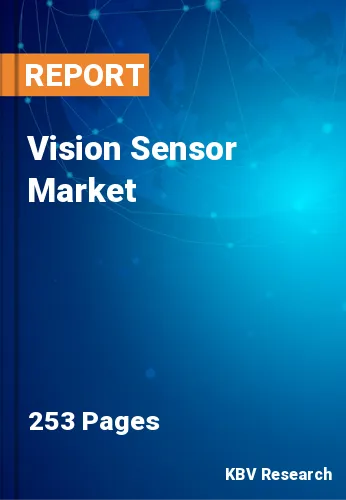
 Drivers
Drivers
 Restraints
Restraints
 Opportunities
Opportunities
 Challenges
Challenges
